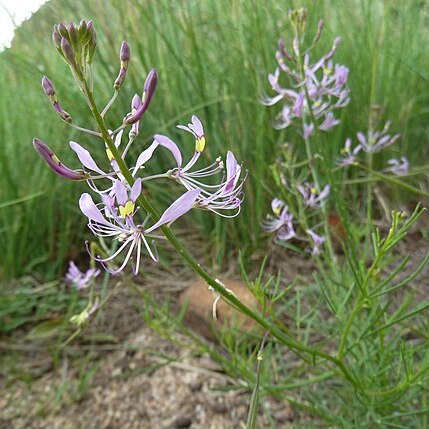Annual herb, up to 300 mm high. Stems erect; glabrous or sparsely puberulous. Leaves 3-5-foliolate; petiolate; leaflets linear, 10-45 x 0.5-1.5 mm; petiole up to 25 mm long. Flowers: stamens fertile and sterile, borne on short receptacle, fertile ones longer than sterile ones; petals pink to mauve; two upper petals with a median yellow band, margined with purple; Dec.-Apr. Fruit 4-10 x 2.5-3.0 mm; seeds brown, ± circular, transversely ridged.
A small herb. It grows 30 cm high. It grows each year from seed. The stem is thin and light green with lines along them. The leaves are compound with 3-5 narrow leaflets. The leaflets are 4-5 cm long by about 1 mm wide. The flowers are in a loose group at the ends of the branches. The flowers are pink or red. The fruit is a narrow capsule.
Stamens 6–8, slightly connate at the base; 2–4 longer and fertile on slender filaments, as long as the petals; anther-thecae c. 2 mm. long, linear-oblong; 2–4 sterile stamens slightly shorter with a clavate swelling at the top of the filaments and reduced, abortive anther-thecae up to 0.75 mm. long which are occasionally partially fertile.
Petals pink to violet, the two slightly shorter upper ones having a median, bright yellow, dark violet or purple-margined band, 1–1.5 x 0.15–0.25 cm.; lamina oblong-elliptic, blunt at the apex or somewhat apiculate, with a basal claw as long as or almost as long as the lamina.
Erect annual herb, up to 300 mm tall. Leaves 3-5-fo-liolate. Two upper petals with median yellow band margined with purple. Stamens fertile and sterile, borne on short receptacle, fertile ones longer. Flowers pink to mauve.
Capsule 4–10 x 0.25 cm., on a glabrous gynophore up to 1 cm. long; valves linear, tapering to both ends, very sparsely puberulous or glabrous, with 3–4 longitudinal nerves; persistent style up to 7 mm. long.
Leaves 3–5-foliolate, leaflets 1–3.5 x 0.05–0.15 cm., linear, subacute, minutely and sparsely asperous-puberulous or glabrous; petioles up to 2.5 cm. long.
Inflorescence of lax terminal racemes; bracts up to 1 mm. long, linear, caducous; pedicels up to 7 mm. long, slender, sparsely setulose-puberulous.
Erect annual herb c. 0.3 m. tall, usually branched; stems striate, glabrous or minutely and sparsely asperous.
Ovary linear, sparsely puberulous, on a gynophore c. 0.5 mm. long; style c. 1 mm. long; stigma subcapitate.
Sepals 1.5–2 mm. long, narrowly lanceolate, acute, setulose-puberulous on the keel and margins.
Seeds brown, c. 1.5 mm. in diam., transversely ridged.

